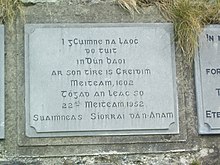Dunboy Castle: Difference between revisions
m Remove blank line(s) between list items per WP:LISTGAP to fix an accessibility issue for users of screen readers. Do WP:GENFIXES and cleanup if needed. Discuss this at Wikipedia talk:WikiProject Accessibility#LISTGAP |
Rescuing 1 sources and tagging 0 as dead. #IABot (v1.5.2) |
||
| Line 23: | Line 23: | ||
{{commons category|Dunboy Castle}} |
{{commons category|Dunboy Castle}} |
||
*[http://www.bearatourism.com Beara Tourism website] |
*[http://www.bearatourism.com Beara Tourism website] |
||
*[http://www.bearainfo.com Beara Information Resource site] |
*[https://web.archive.org/web/20051210041642/http://www.bearainfo.com/ Beara Information Resource site] |
||
{{coord|51.633|-9.924|region:IE_type:landmark|display=title}} |
{{coord|51.633|-9.924|region:IE_type:landmark|display=title}} |
||
Revision as of 18:33, 14 September 2017



Dunboy Castle (Irish: Caisleán Dhún Baoi) is a ruined castle on the Beara Peninsula in south-west Ireland near the town of Castletownbere. It was a stronghold of the O'Sullivan Bere, a Gaelic clan leader and 'Chief of Dunboy', and was built to guard and defend the harbour of Berehaven. Its presence enabled O'Sullivan Bere to control the sea fisheries off the Irish coast and collect taxes from Irish and continental European fishing vessels sheltering in the haven. It was also a centre for the import/export trade to and from the continent. Today, much of the castle is destroyed but the ruins are open to the public.
Dunboy Castle was the scene of the noted Siege of Dunboy in the summer of 1602 which ultimately led to its destruction and the breaking of the power of the O'Sullivan Bere. At that time Donal Cam O'Sullivan Bere was in rebellion against the English crown and Elizabeth I had sent a 5000-strong army under the command of Sir George Carew to suppress the insurgents. Even with its small garrison of 143 men Dunboy Castle was thought to be impregnable but following a fierce artillery bombardment the walls were smashed and after some desperate hand-to-hand fighting amid the rubble the defenders were finally overcome. The 58 survivors of the two-week siege were executed in the nearby market square.
Near the castle ruins stands Puxley Mansion, a 19th-century manor house.[1] It was burnt by the IRA in 1920 in reprisal for the destruction of houses that harboured IRA men and weapons by the Crown Forces. While some restoration work was completed in the 2000s, funding issues halted plans to refurbish the mansion and open it as a hotel.[2]
See also
References
- ^ Frommer's Ireland 2008 By Christi Daugherty. Page 299.
- ^ Louise, Roseingrave (16 June 2011). "Funds run out for Puxley restoration". Irish Times. Retrieved 31 July 2015.
- Pól Uí Súileabháin, "The Last Chieftain of Gaelic Ireland: The True Story of Donal O'Sullivan Bere", Published 2004 with the assistance of the Beara Historical Association.
- T. D. Sullivan, "Bantry, Berehaven and the O'Sullivan Sept", Tower Books, Cork, 1978.
- Gerard (Gerdie) Harrington, "In the Path of Heroes: Stories of Beara and Bantry", The Beara Historical Association.

